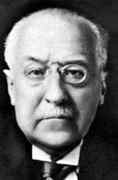Person: Picard (2), Émile

Émile Picard worked in algebraic geometry as well as elasticity, heat and electricity.
Mathematical Profile (Excerpt):
- As well as Émile, she had a second young son, and in order to support them through their education she had to find employment.
- Only her determination to give her sons a good start, despite the tragedy, allowed Émile to receive the education which gave him the chance to achieve the highest international stading in mathematics.
- Picard's secondary education was at the Lycée Napoléon, later called the Lycée Henri IV.
- It was only during the vacation after completing his secondary studies that Picard read an algebra book and suddenly he became fascinated in mathematics.
- Picard received his agrégation in 1877, being placed first.
- In 1881 Picard was nominated for membership of the mathematics section of the Académie des Sciences.
- He had already proved two important theorems which are both today known under Picard's name, yet it was still a little soon to gain admission to the prestigious academy and he would have to wait a few more years.
- In 1885 Picard was appointed to the chair of differential calculus at the Sorbonne in Paris when the chair fell vacant on the death of Claude Bouquet.
- The regulations were circumvented by making Picard his own suppléant until he reached the age of thirty which was in the following year.
- Picard made his most important contributions in the fields of analysis, function theory, differential equations, and analytic geometry.
- Picard's solution was represented in the form of a convergent series.
- Picard used the theory of Hermite's modular functions in the proof of this important result.
- Building on work by Abel and Riemann, Picard's study of the integrals attached to algebraic surfaces and related topological questions developed into an important part of algebraic geometry.
- Picard also discovered a group, now called the Picard group, which acts as a group of transformations on a linear differential equation.
- Picard examined several specific cases before discussion his general theory.
- Picard also applied analysis to the study of elasticity, heat and electricity.
- Among the honours given to Picard was his election to the Académie des Sciences in 1889, eight years after he was first unsuccessfully nominated.
- Picard was awarded the Poncelet Prize in 1886 and the Grand Prix des Sciences Mathématiques in 1888.
Born 24 July 1856, Paris, France. Died 11 December 1941, Paris, France.
View full biography at MacTutor
Tags relevant for this person:
Astronomy
Thank you to the contributors under CC BY-SA 4.0! 

- Github:
-

- non-Github:
- @J-J-O'Connor
- @E-F-Robertson
References
Adapted from other CC BY-SA 4.0 Sources:
- O’Connor, John J; Robertson, Edmund F: MacTutor History of Mathematics Archive
